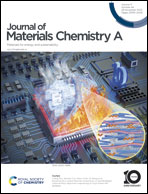Tailoring the Pt/ionomer interface for enhancing the local oxygen transport in proton exchange membrane fuel cells†
Abstract
In order to realize the high-power operation of low-cost proton exchange membrane fuel cells, it is urgent to solve the problem of oxygen mass transfer in a low Pt loading cathode at high current density. More exactly, the high local oxygen transport resistance (Rionomer) originating from the dense ionomer film on the Pt surface results in significant voltage losses. Herein, this paper proposes an exceptionally simple and cost-effective strategy to precisely regulate a Pt/ionomer interface to decrease Rionomer only by introducing hydrophobic nano-SiO2 into a cathode catalyst layer. As a result, the cathode catalyst layer modified by nano-SiO2 with a particle size of 10 nm and a content of 10% exhibits optimal mass transfer characteristics, and a specific Pt/ionomer interface with low Rionomer is established. The microstructure characterization of the catalyst layer confirms that the majority of ionomer adheres to nano-SiO2 particles and evenly distributes around the Pt/C agglomerates. Moreover, the stronger affinity of nano-SiO2 to ionomer is verified by molecular dynamics simulation. Collectively, the ability of nano-SiO2 to capture ionomer effectively reduces the ionomer density on the Pt surface, thus establishing a highly efficient oxygen-delivering Pt/ionomer interface. This work highlights an extremely promising method for Pt/ionomer interface construction of catalyst layer with high oxygen mass-transfer characteristics.



 Please wait while we load your content...
Please wait while we load your content...